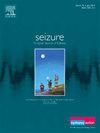Association between anti-seizure medications and cardiac arrhythmias in patients undergoing ambulatory electroencephalographic and electrocardiographic monitoring
IF 2.7
3区 医学
Q2 CLINICAL NEUROLOGY
引用次数: 0
Abstract
Background Anti-seizure medications (ASMs) are commonly prescribed in epilepsy. However some have been associated with adverse cardiac outcomes including cardiac arrhythmias.
Methods We conducted an observational study evaluating patients aged ≥16 years undergoing ambulatory video – electroencephalographic (EEG) – electrocardiographic (ECG) monitoring (AVEEM) between 2020 and 2023 in Australia. Data collected included baseline demographics, type, number and dose of ASMs and cardiac arrhythmias during monitoring. ASMs were not withdrawn while monitored. Average QT interval was calculated and corrected for heart rate (QTc). Logistic regression was used to evaluate association between demographic variables, ASMs and cardiac arrhythmias.
Results 3695 patients underwent AVEEM (median age 40 years [interquartile range 26–57], female 64 %). Median AVEEM duration was 6.8 days. 51 % of patients were taking ≥1 ASMs. About 28 % (1029/3695) patients had a cardiac arrhythmia; the most frequent was non-sustained SVT (19 %; 695/3695). On multivariable analysis, carbamazepine (OR 0.72, 95 %CI 0.53–0.98, p = 0.03), lamotrigine (OR 0.57, 95 %CI 0.44–0.73, p<0.001) and lacosamide (OR 0.63, 95 %CI 0.43–0.92, p = 0.02) were associated with fewer cardiac arrhythmias. Their association with cardiac arrhythmias was not dose-dependent. No commonly-prescribed ASMs were associated with increased risk of cardiac arrhythmias. There was no significant association between use of ASMs and dynamic QTc interval change.
Conclusions Certain ASMs, namely carbamazepine, lamotrigine and lacosamide, were associated with fewer cardiac arrhythmias and this association was not dose-dependent. No other ASM was associated with cardiac arrhythmias. Further large clinical prospective studies are needed to confirm these findings and to clarify the mechanism for any potential antiarrhythmic properties of ASMs.
在接受动态脑电图和心电图监测的患者中,抗癫痫药物与心律失常的关系。
背景抗癫痫药物(asm)通常用于治疗癫痫。然而,一些与不良的心脏结果有关,包括心律失常。方法:我们在澳大利亚进行了一项观察性研究,评估了2020年至2023年间接受动态视频-脑电图(EEG) -心电图(ECG)监测(AVEEM)的年龄≥16岁的患者。收集的数据包括监测期间的基线人口统计、asm和心律失常的类型、数量和剂量。在监测期间不停用asm。计算平均QT间期并校正心率(QTc)。采用Logistic回归评估人口统计学变量、asm与心律失常之间的相关性。结果3695例患者行AVEEM手术(中位年龄40岁[四分位数范围26-57岁],女性64%)。中位AVEEM持续时间为6.8天。51%的患者服用≥1次asm。约28%(1029/3695)的患者有心律失常;最常见的是非持续性SVT (19%;695/3695)。在多变量分析中,卡马西平(OR 0.72, 95% CI 0.53-0.98, p = 0.03),拉莫三嗪(OR 0.57, 95% CI 0.44-0.73, p = 0.03)
本文章由计算机程序翻译,如有差异,请以英文原文为准。
求助全文
约1分钟内获得全文
求助全文
来源期刊

Seizure-European Journal of Epilepsy
医学-临床神经学
CiteScore
5.60
自引率
6.70%
发文量
231
审稿时长
34 days
期刊介绍:
Seizure - European Journal of Epilepsy is an international journal owned by Epilepsy Action (the largest member led epilepsy organisation in the UK). It provides a forum for papers on all topics related to epilepsy and seizure disorders.
 求助内容:
求助内容: 应助结果提醒方式:
应助结果提醒方式:


